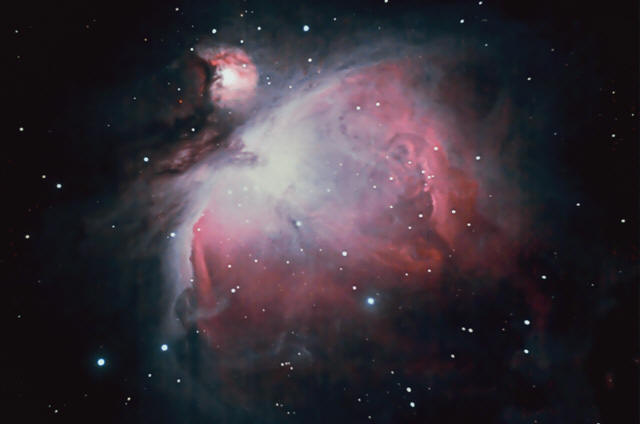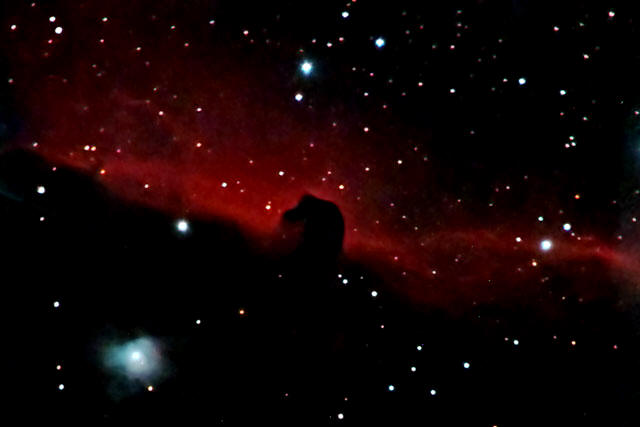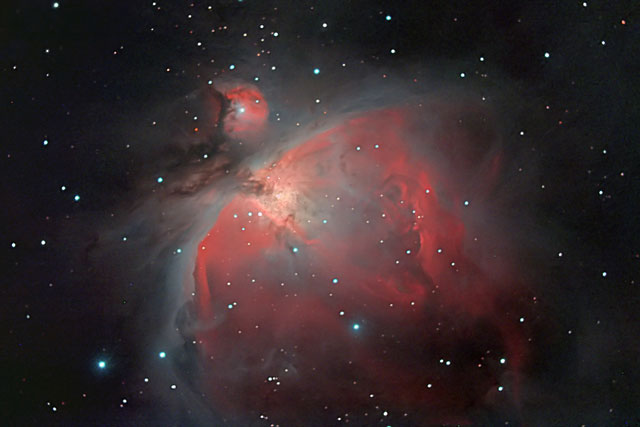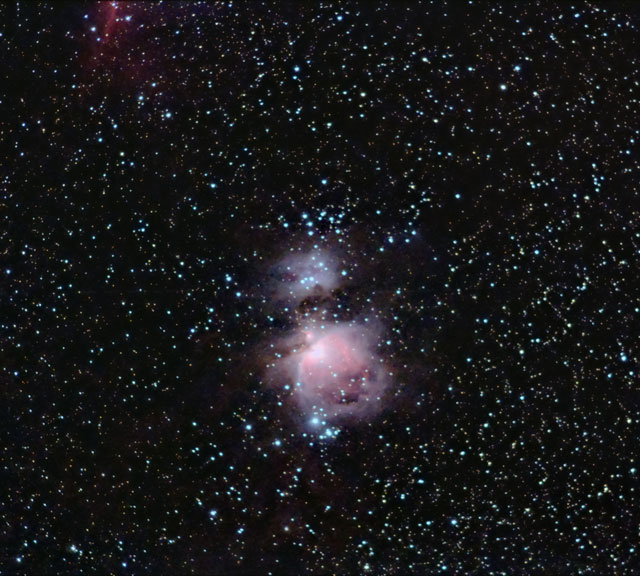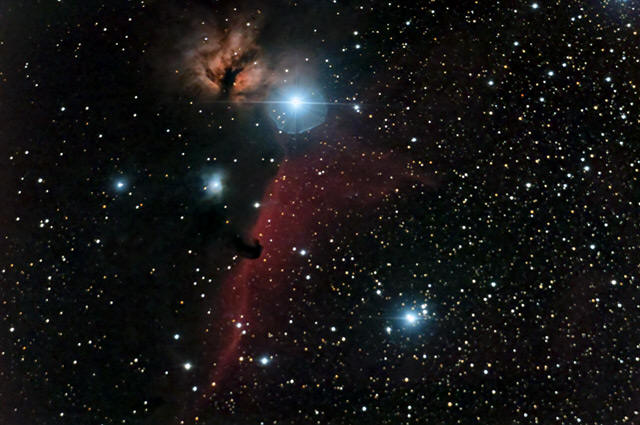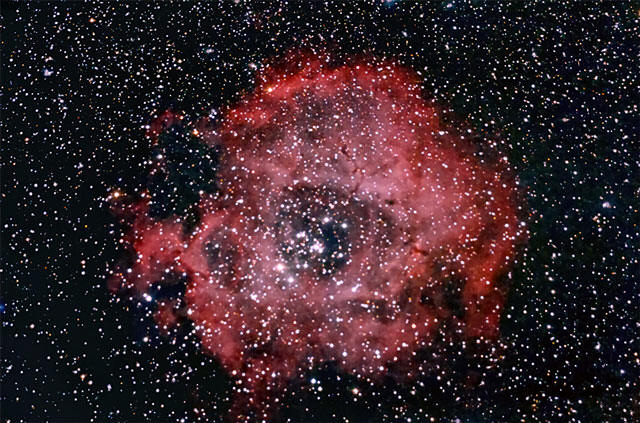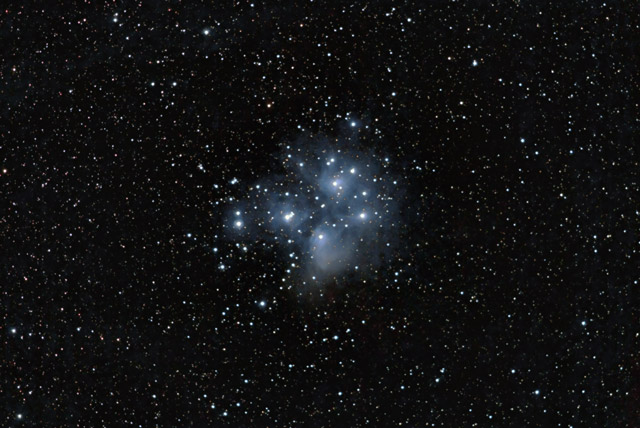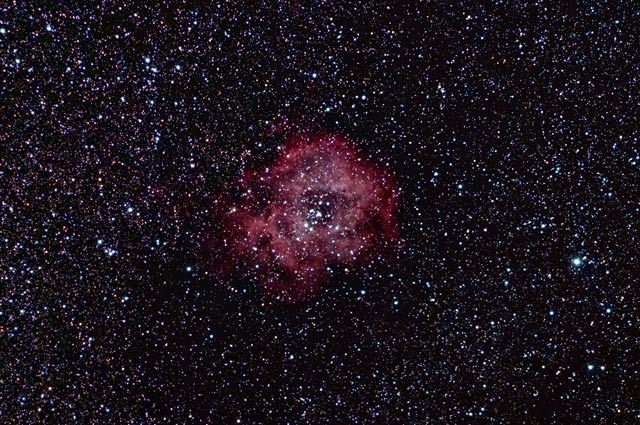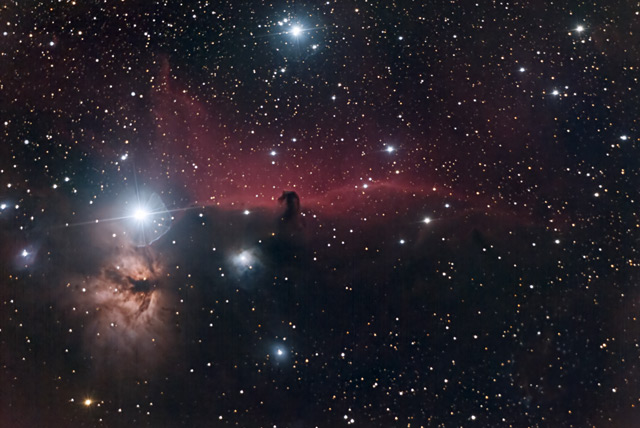______________________
|
On the second day of the new year, a cold front passed through and left behind clear skies. I setup my scope that night for prime focus imaging and planned to do some different exposures than what I had been using. The Orion Nebula is in prime position so I used it again for "testing." :-) |
|
The Orion Nebula on 1/2/06. Celestron C-8, F/5.8 focal reducer, Canon 300D and a Deep Sky Filter. Exposure was 15x150 second sub-images at 800 ISO processed and stacked in IRIS with dark, flat and bias calibration. Photoshop, RC-Astro's Gradient XTerminator and Noel Carboni's Astronomy Tools for post processing. |
______________________
|
After trying many times, I finally obtained a half-decent image of the Pinwheel Galaxy, M33, in Triangulum. I had to use my C-8 to get the kind of detail that eluded me in images done with my smaller imaging scopes. I am pleased with the image, at least for the time being. |
|
M33, The Pinwheel Galaxy in Triangulun on 1/3/06. Celestron C-8, F/5.8 focal reducer, Canon 300D and a Deep Sky Filter. Exposure was 15x300 second sub-images at 1600 ISO processed and stacked in IRIS with dark, flat and bias calibration. Photoshop, RC-Astro's Gradient XTerminator and Noel Carboni's Astronomy Tools for post processing. |
______________________
First Light: Hutech Spectrum Enhanced
Canon Digital Rebel 350 XT
1/13/06
|
Despite a full moon on the night of January 13th, 2006, I wanted to image some Deep Sky Objects. Why in the world would I want to try that on a full moon night? Was I suffering from some kind of Moon Madness? No! You want to know why? Well, the reason is I had just taken delivery on my new Hutech Canon Digital Rebel 350 XT and I just had to try it out! LoL! :-) |
|
First Light image: The Horse Head Nebula on 1/13/06. Celestron C-8, F/5.8 focal reducer, Hutech / Canon Digital Rebel 350 XT and a Deep Sky Filter. Exposure was 8x300 second sub-images at 1600 ISO processed and stacked in IRIS with dark, flat and bias calibration. Photoshop, RC-Astro's Gradient XTerminator and Noel Carboni's Astronomy Tools for post processing. Final noise reduction in Neat Image. |
|
The Orion Nebula on 1/13/06. Celestron C-8, F/5.8 focal reducer, Hutech / Canon Digital Rebel 350 XT and a Deep Sky Filter. Exposure was 3x300 second sub-images and 5x30 second sub-images (for the core region) at 1600 ISO processed and stacked in IRIS with dark, flat and bias calibration. Photoshop, RC-Astro's Gradient XTerminator and Noel Carboni's Astronomy Tools for post processing. Final noise reduction in Neat Image. |
______________________
The Andromeda Galaxy and
The Orion Nebula
On 1/17/06
|
With the full moon rising in only 3 hours and very windy conditions, I decided to use my trusty Canon 200mm F/2.8 lens for some quick deep sky images. The wind precluded using anything with more magnification. It was also a good time to see how well my new Hutech / Canon Digital Rebel 350 XT would perform with this lens. |
|
The Andromeda Galaxy on 1/17/06. Hutech / Canon Digital Rebel 350 XT and a Canon 200mm F2.8 lens piggybacked on my C-8. Exposure was 21x30 second sub-images at 1600 ISO processed and stacked in IRIS with dark, flat and bias calibration. Photoshop, RC-Astro's Gradient XTerminator and Noel Carboni's Astronomy Tools for post processing. Final noise reduction in Neat Image. |
|
The Orion Nebula region on 1/17/06. Hutech / Canon Digital Rebel 350 XT and a Canon 200mm F2.8 lens piggybacked on my C-8. Exposure was 10x30 second sub-images at 1600 ISO processed and stacked in IRIS with dark, flat and bias calibration. Photoshop, RC-Astro's Gradient XTerminator and Noel Carboni's Astronomy Tools for post processing. Final noise reduction in Neat Image. |
______________________
The Horse Head Nebula
on 1/18/06
|
I am having a ball with my new camera! It is so fun to try it out on objects I have previously imaged and see the difference in quality between the images. It is an amazing improvement, let me tell you! The Horse Head Nebula is in prime position early in the evening, so I decided to try to get a better image of it. In addition to the new camera, I picked up an orange tube Celestron Comet Catcher and this image is it's first light for me. The new Comet Catcher seems to have much better image quality than my black tube model It needs a little tweaking, but so far it is living up to my expectations. |
|
The Horse Head Nebula on 1/18/06. Hutech / Canon Digital Rebel 350 XT and a Celestron Comet Catcher 500mm F3.6 scope piggybacked on my C-8. Exposure was 3x120 second and 11x60 second sub-images at 1600 ISO. Processed and stacked in IRIS with dark, flat and bias calibration. Photoshop, RC-Astro's Gradient XTerminator and Noel Carboni's Astronomy Tools for post processing. Noise reduction in Neat Image. |
______________________
|
The weather conditions have been horrible for astrophotography lately. After almost 2 weeks of bad weather, conditions improved for a night recently. Unfortunately, equipment problems prevented me from getting any useable images. One more night with only marginal conditions occurred a few nights later on January 27, 2006. I was still fighting an equipment problem with my Celestron Comet Catcher. I tried collimating it by eye, but this little scope needs a special tool to help get good collimation. I messed it up more than it was when I first got it. To help fix it, I purchased a used laser collimation tool, but I still do not have it set right. Oh, well... here is an image I took after trying my best to put the scope back into alignment: |
|
The Rosette Nebula on 1/27/06. Hutech Type 1 modified Canon Digital Rebel 350 XT and a Celestron Comet Catcher 500mm F3.6 scope piggybacked on my C-8. Exposure was 15x60 second sub-images at 1600 ISO. Processed and stacked in IRIS with dark, flat and bias calibration. Photoshop, RC-Astro's Gradient XTerminator and Noel Carboni's Astronomy Tools for post processing. Noise reduction in Neat Image. |
______________________
The Pleiades, Belt of Orion
and the Rosette Nebula
On
1/29/06
|
On Sunday, January 29th, 2006 I was supposed to test my Comet Catcher's collimation again. Unfortunately, the wind was blowing a little too hard to piggyback that heavy of a scope. So, I used my Canon 200mm F/2.8 telephoto lens instead and managed to get some images despite the windy conditions. I shot the Pleiades first, but didn't expect much since the telescope shook a lot with some gusty winds. Then, I decided to go after the Rosette Nebula, this time with the 200mm. I finished off with the Belt of Orion region. For the Rosette, the winds calmed down. So I fine tuned the guiding and it went rather well. They picked back up while I was shooting the Orion region. My telescope lost it's guide star while I was inside at one point. About a dozen of the subs at the end of that run were no good. Anyway, here are the images and you can see how well I faired despite the wind: |
|
The Pleiades on 1/29/06. Hutech / Canon Digital Rebel 350 XT and a Canon 200mm F2.8 lens piggybacked on my C-8. Exposure was 26x30 second sub-images at 1600 ISO processed and stacked in IRIS with dark, flat and bias calibration. Photoshop, RC-Astro's Gradient XTerminator and Noel Carboni's Astronomy Tools for post processing. Final noise reduction in Neat Image. |
|
The Rosette Nebula on 1/29/06. Hutech / Canon Digital Rebel 350 XT and a Canon 200mm F2.8 lens piggybacked on my C-8. Exposure was 10x30 second sub-images at 1600 ISO processed and stacked in IRIS with dark, flat and bias calibration. Photoshop, RC-Astro's Gradient XTerminator and Noel Carboni's Astronomy Tools for post processing. Final noise reduction in Neat Image. |
|
The Belt of Orion region on 1/29/06. Hutech / Canon Digital Rebel 350 XT and a Canon 200mm F2.8 lens piggybacked on my C-8. Exposure was 22x30 second sub-images at 1600 ISO processed and stacked in IRIS with dark, flat and bias calibration. Photoshop, RC-Astro's Gradient XTerminator and Noel Carboni's Astronomy Tools for post processing. Final noise reduction in Neat Image. |
______________________
The
Horse Head Nebula
on 1/30/06
|
Here is an image I did to test the collimation of my 5.5 inch, Celestron Comet Catcher Schmidt-Newtonian. I wanted to get the Horse Head Nebula with the camera oriented with east towards the top so the nebula would fill the long dimension of the frame. Instead of trying to rotate the camera body on the T-adapter, I just rotated the whole tube in the rings to get it lined up. The collimation is still off a bit, it seems. It's getting closer, though. A little more tweaking and it will be ready to image galaxies in Virgo and Leo! |
|
The Horse Head Nebula on 1/30/06. Hutech / Canon Digital Rebel 350 XT and a Celestron Comet Catcher 500mm F3.6 scope piggybacked on my C-8. Exposure was 36x90 second sub-images at 1600 ISO. Processed and stacked in IRIS with dark, flat and bias calibration. Photoshop, RC-Astro's Gradient XTerminator and Noel Carboni's Astronomy Tools for post processing. Noise reduction in Neat Image. |
